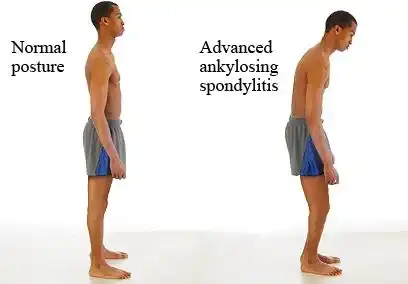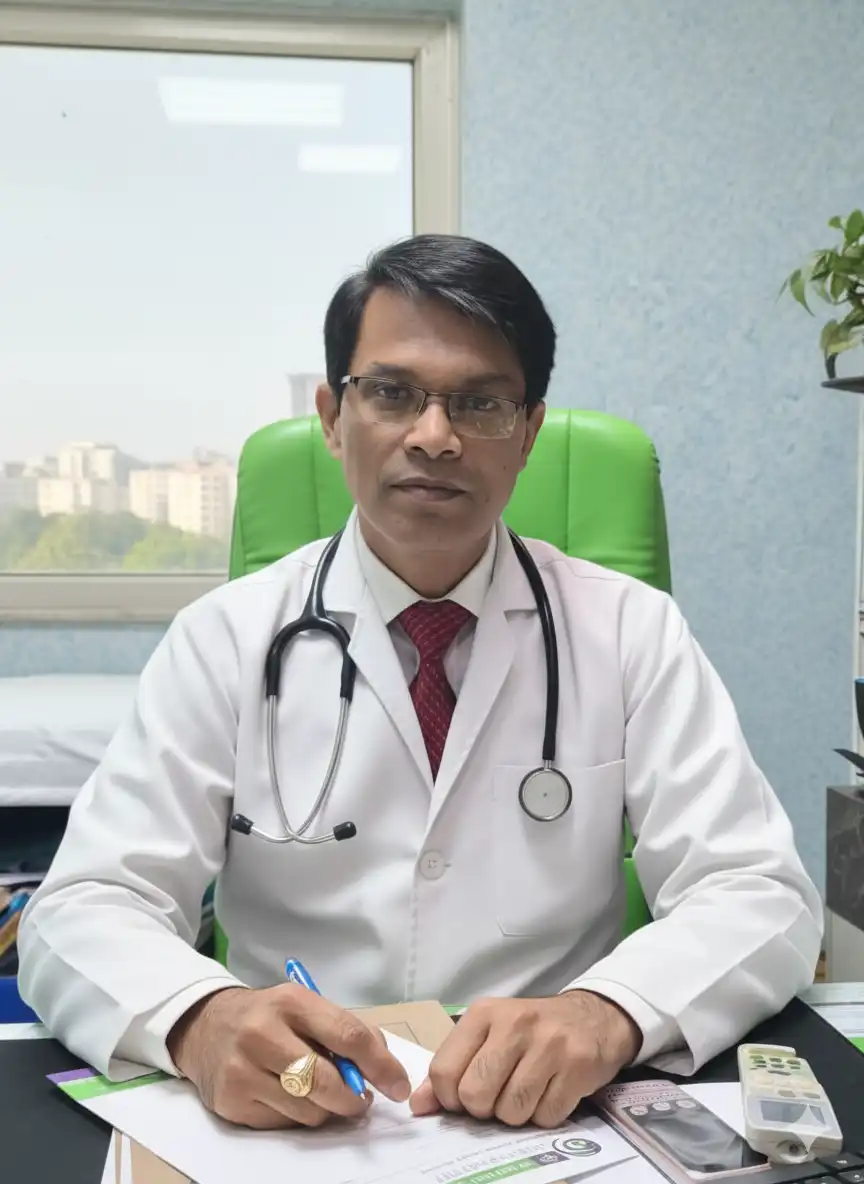
What is Ankylosing Spondylitis?
Ankylosing spondylitis (AS) is a chronic inflammatory disease that typically begins in early adulthood and primarily affects the axial skeleton, particularly the sacroiliac joints and spine.

Ankylosing spondylitis (AS) also affects the joints where the base of your spine meets your pelvis (your sacroiliac joints). Your sacroiliac joints are the connection between your spine and pelvis. Specifically, they’re the place where the sacrum (the triangle-shaped last section of your spine) meets the ilium (the top and back part of your pelvis).
The sacroiliac joints are some of the biggest joints in your body, and you use them every time you move or shift your hips.
It’s less common, but ankylosing spondylitis can affect other joints, including your:
- Shoulders
- Hips
- Knees
Ankylosing spondylitis causes pain, stiffness and gastrointestinal (GI) symptoms. Visit a healthcare provider if you’re experiencing lower back pain, especially if it’s getting worse or making it hard to do all your usual daily activities.
Symptoms of Ankylosing Spondylitis
The most common symptoms are back pain and stiffness.
- Back pain- Back pain is the main symptom. Pain usually starts in the lower back and typically becomes gradually worse over several months. There may also be pain in the buttocks and down the back of the thighs. The buttock pain may be felt sometimes on one side and sometimes on the other side. Coughing or straining may make pain worse. Rest does not make it better. In fact, pain may be worse at night and better on getting up in the morning. Exercise and movement usually ease the pain. (This is the opposite of most bouts of common nonspecific lower back pain, which may alert a doctor to the diagnosis of AS.) The pain tends to ease as the day goes on. The middle section of the spine (thoracic vertebrae) may also become affected. If this occurs, the joints between the ribs and the spine may also become painful.
- Stiffness in the lower spine- The stiffness can be quite severe first thing each morning. It usually improves with activity and exercise, and tends to ease as the morning goes on.
- Other joint symptoms apart from the spine- Other joints are affected at some stage in about 4 out of every 10 people with AS. The most common are the hips, knees, ankles, and shoulders. Affected joints can become painful, stiff, and swollen.
- Inflammation of tendons and ligaments – Tendons and ligaments in various parts of the body (in addition to those attached to the vertebrae of the lower spine) may become inflamed and painful where they attach to bones. Common examples are the Achilles tendon (Achilles tendinopathy), where the calf muscles attach to the heel, and where chest muscles attach to the ribs (costochondritis).
- Inflammation of part of the eye (uveitis)- Uveitis is an inflammation of the eye. It affects about 1 in every 3 people with AS from time to time. People with AS who develop a painful or red eye should seek medical advice. Uveitis will usually be diagnosed by an eye specialist in an emergency department, and treatment with eye drops should be started as soon as possible after eye symptoms begin. Treatment of uveitis is usually successful. However, if not treated quickly, there can be permanent loss of vision in the eye (partial or complete).
- General symptoms- Some people with AS feel generally unwell with symptoms of tiredness or depression. Unintended weight loss or anaemia sometimes occurs.
What causes Ankylosing spondylitis?
The exact cause is not known. However, there is a strong genetic tendency. There is a strong association with a gene variant called HLA-B27. About 9 out of every 10 people with ankylosing spondylitis have this gene variant compared with fewer than 1 out of every 10 in the general population. However, having HLA-B27 does not automatically lead to AS. 94 out of 100 people with HLA-B27 will not develop AS. Also, some people develop AS who do not have this gene variant. It is thought that something may trigger AS to develop in people who have an inherited tendency to develop AS, and that HLA-B27 provides a strong tendency. As yet, the trigger is unknown, and other genes and factors may also be involved in causing AS.
Who gets Ankylosing spondylitis?
Ankylosing spondylitis most commonly develops between 20 and 30 years of age. 80 out of 100 people will develop symptoms before the age of 30, and only 5 in 100 will first develop symptoms over the age of 45. It is twice as common in men as it is in women. There may be a family history with two or more members of a family being affected.
Risk Factors
There are a number of factors that put you at risk of developing Ankylosing Spondylitis.
- Sex: Men are more likely to develop this condition than women.
- Heredity: Most cases of Ankylosing Spondylitis carry the HLA-B27 (Human leukocyte antigen) gene. However, in many cases, those missing the gene have also developed the condition.
- Age: Ankylosing Spondylitis occurs mostly in late adolescence and young adulthood.
Associated conditions
Some other conditions develop more commonly than would be expected in people who have AS. People with AS have a greater than average chance of developing:
- Ulcerative Colitis
- Crohn’s disease
- Psoriasis
- Thinning of the bones (osteoporosis)
- Lung fibrosis
- Cardiovascular disease
- Heart valve problems
How does ankylosing spondylitis progress?
Symptoms can vary in severity and usually wax and wane. Flare-ups of inflammation, which cause periods of worse pain and stiffness, tend to occur from time to time. If joints outside of the spine are affected, they tend to flare up at the same time as back symptoms. The number of flare-ups that occur, how severe they are, and how long they last, can vary greatly from person to person.
In time, the movement and flexibility of the spine may reduce. This happens as the inflammation and bony growths cause gradual joining together (fusion, or ankylosis) of some of your bones. The number of vertebrae involved and how much fusion happens vary from person to person. A bent-over, stooping posture may develop if it is very severe.
Homoeopathic approach for Ankylosing Spondylitis Treatment
The conventional mode of treatment can offer only pain management with the help of pain killers & NSAIDs, that to at the cost of various side effects like nausea, vomiting, weight loss, peptic ulcers, etc. Hence, a lot of patients prefer alternative therapies like homeopathy for substantial relief. Homoeopathy is based on its time-tested principle of Individualisation. Every person reacts differently & uniquely to any stress. Homoeopath identifies this unique reaction & bases his prescription upon it.
Homoeopathic management of Ankylosing Spondylitis
- Rhus Toxicodendron: Pain between the shoulders, especially on swallowing. The small of the back is very painful, which is better on motion, lying on something hard, and worse on sitting. Marked stiffness of the nape of the neck. Lumbago is generally associated with sciatica.
- Kali Carbonicum: This medicine has a characteristic action on the small of the back. The small of the back feels very weak. Patient feels stiffness & paralytic type of pain in the back. Pains radiate from the hips to the knee.
- Calcarea Fluorica: It is a great remedy for osseous tumors & bony overgrowths. Patient will complain of chronic lumbago, worse at the beginning of movement & ameliorated with continued motion. A burning type of pain is felt in the lower part of the back.
- Nux Vomica: Backache, especially in the lumbar region. A burning type of pain is present in the spine, which is worse at 3 to 4 am. cervical-brachial neuralgic pain, which is worse on touch.
- Natrum muriaticum: There is great sensitiveness between vertebrae, relieved by lying on the back & upon something hard. The Patient complains of paralysis to weakness in the spine. Backache is generally worse in the morning. Restlessness & debility are marked.
Why choose Dr. Sanjay’s Homoeopathy for Ankylosing Spondylitis treatment in Lucknow, India?
Dr. Sanjay’s Homoeopathy is a trusted clinic for safe and effective ankylosing spondylitis treatment in Lucknow, India. With years of clinical expertise, Dr. Sanjay provides specialised ankylosing spondylitis homeopathic treatment in Lucknow, India that helps reduce back pain, stiffness, inflammation, and improve mobility naturally without side effects. As a leading homeopathic doctor in Lucknow, he follows international treatment standards and offers personalised care to manage this chronic spinal condition at its root. Patients choose Dr. Sanjay’s Homoeopathy for its holistic healing, long-term relief, and compassionate approach in treating complex autoimmune disorders like ankylosing spondylitis.
Patients from across the world trust Dr. Sanjay’s Homoeopathy for Ankylosing Spondylitis treatment in Lucknow, India. Dr. Sanjay Singh, who led this clinic, has successfully treated thousands of patients with Ankylosing Spondylitis, which makes him the best doctor for Ankylosing Spondylitis treatment in Lucknow.
